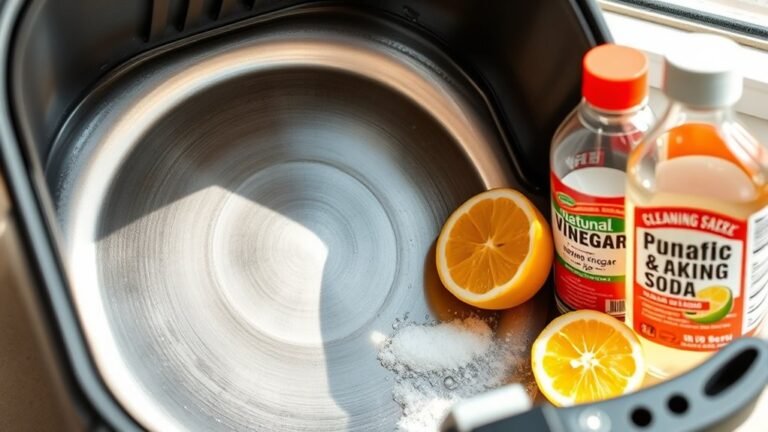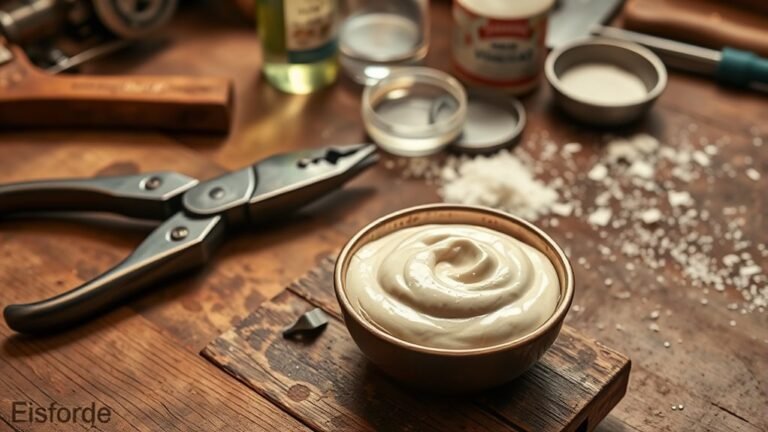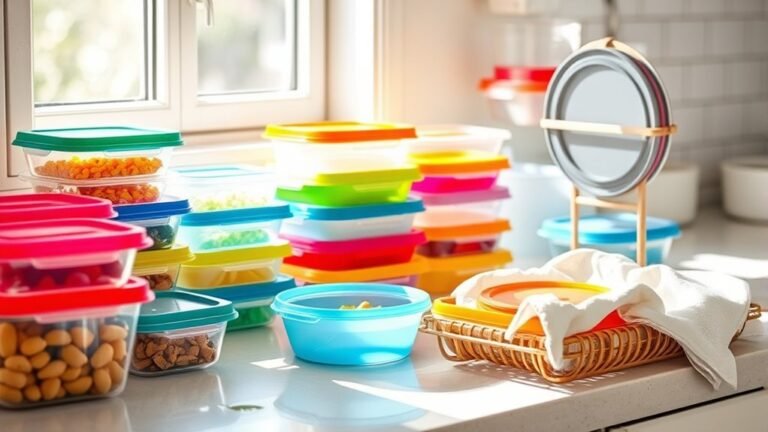Cleaning Tips Before and After Refrigerator
Before cleaning your refrigerator, unplug it and empty all food, checking expiration dates to avoid odors. Use mild cleaners like baking soda or vinegar with soft cloths to clean shelves, doors, and handles thoroughly. After cleaning, dry parts completely before reassembling. Wipe spills daily and organize items to prevent mess buildup. Regularly disinfect handles and group groceries by type for easy access. Keep up with these simple steps, and you’ll find your fridge stays fresh and efficient much longer. Explore more tips to maintain a spotless fridge effortlessly.
Preparing Your Refrigerator for Cleaning
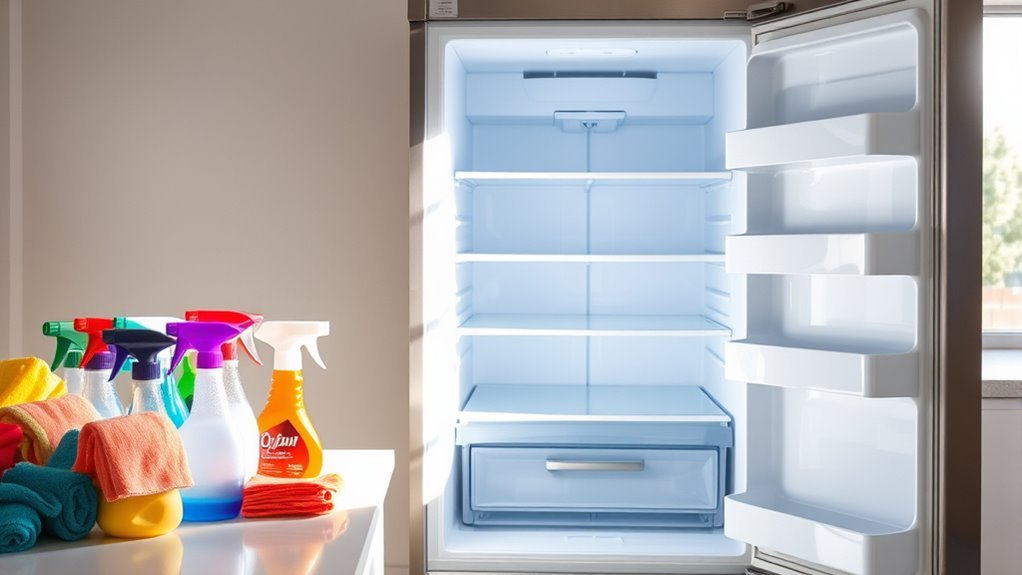
Before you plunge into cleaning, make certain you unplug your refrigerator to secure safety. This simple step not only protects you but also prevents any electrical mishaps during your refrigerator maintenance. Next, stick to a consistent cleaning schedule to keep your appliance functioning efficiently and extend its lifespan. You’ll want to empty out all perishables, checking expiration dates as you go—this lets you declutter and avoid bad odors. Remove shelves and drawers carefully, so you can clean every nook without damage. Taking these preparatory steps guarantees your cleaning process is smooth, effective, and safe. By embracing this routine, you gain freedom from unexpected breakdowns and enjoy a fresher, well-maintained refrigerator that complements your lifestyle effortlessly.
Gathering Essential Cleaning Supplies
You’ll need just a handful of key supplies to clean your refrigerator thoroughly and efficiently. Start by gathering essential tools like microfiber cloths, a soft sponge, and a sturdy brush for scrubbing stubborn spots. Have a spray bottle filled with a gentle, non-toxic cleaning solution—something safe enough for food surfaces but strong enough to cut through grime. Baking soda mixed with water works perfectly as a natural cleaner and deodorizer. Don’t forget rubber gloves to protect your hands and a bucket to rinse your cloths. Keeping these supplies within reach frees you to move swiftly through the cleaning process without interruptions. With the right tools and cleaning solutions on hand, you’ll breeze through this chore, reclaiming your space and peace of mind effortlessly.
Removing All Food Items Safely
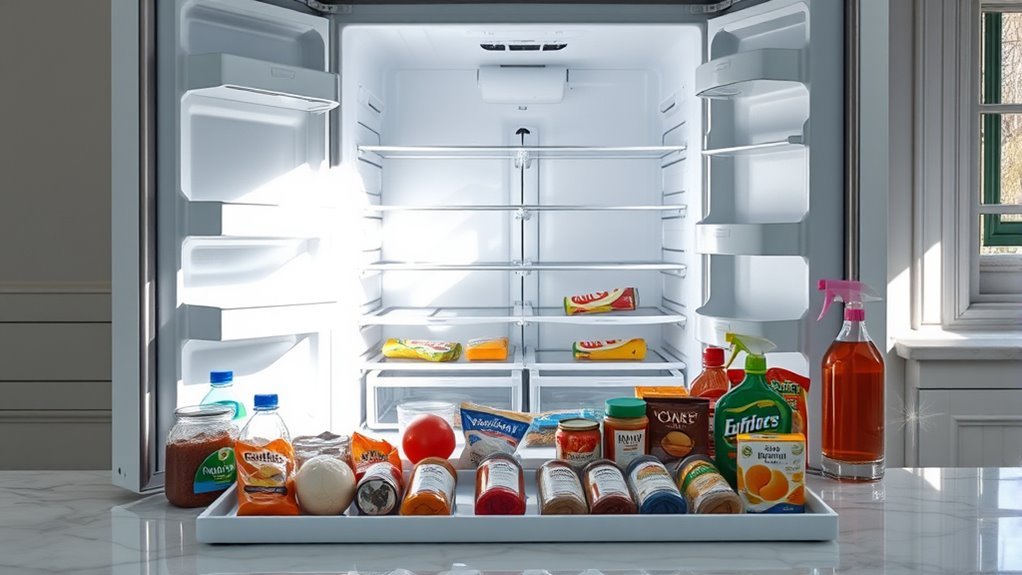
Before you start cleaning, make sure to organize your food items so you can remove them efficiently. Handle perishables with extra care to prevent spoilage during the process. This will help keep everything fresh and make your job easier.
Organizing Food for Removal
When you’re ready to remove food from your refrigerator, start by grouping similar items together to make the process smoother. This simple step helps with efficient item categorization, so you know exactly what you have and what needs attention. Organizing your food storage by categories like dairy, vegetables, and condiments lets you quickly see what’s fresh, what’s expired, and what can be tossed. Use clear containers or bags to keep grouped items together, making transport easier and reducing mess. By taking the time to organize, you free yourself from chaos and streamline the cleaning process. This approach not only saves time but also empowers you to manage your fridge contents with ease and confidence, giving you back control over your kitchen space.
Handling Perishables With Care
Once you’ve sorted your food into categories, it’s time to handle perishables with extra care. To maintain food safety, remove all items like dairy, meat, and fresh produce first and place them in a cooler or insulated bag. This prevents spoilage while you clean. Follow storage guidelines by checking expiration dates and discarding anything questionable. Don’t forget to wipe down containers before putting them aside. Keeping perishables chilled during cleaning helps you avoid any health risks and keeps your freedom to eat fresh and safe meals. Remember, handling food properly now means you won’t have to worry later, making your cleaning routine smoother and your kitchen healthier. Stay mindful and enjoy the liberty of a clean, safe fridge.
Cleaning and Organizing Refrigerator Shelves
Start by taking everything off your refrigerator shelves so you can clean them thoroughly. Use warm, soapy water to wipe down all surfaces and remove any spills or stains. Once dry, organize your items by food type to keep everything easy to find and fresh.
Removing All Items
Before you plunge into cleaning, you’ll need to remove all items from your refrigerator. This step gives you the freedom to start fresh and see exactly what you’ve got. As you take everything out, practice item categorization—group like items together such as dairy, condiments, and leftovers. This helps you spot what’s expired or unnecessary. Don’t hesitate to toss spoiled or unwanted food through proper food disposal methods; your fridge will thank you. Clearing it all out not only makes cleaning easier but also helps you organize better when restocking. Taking control of your fridge contents lets you enjoy a clutter-free, efficient space, giving you freedom from the stress of chaos every time you open the door.
Washing Shelf Surfaces
Scrub down your refrigerator shelves with warm, soapy water to remove spills and sticky residues that can attract bacteria. Once the visible grime is gone, consider using effective shelf sanitization methods to guarantee a deeper clean. You don’t have to rely on harsh chemicals—eco friendly cleaners like diluted vinegar or baking soda solutions work wonders without compromising your health or the environment. After washing, rinse the shelves thoroughly and let them air dry completely before placing them back. Taking this simple step not only keeps your fridge hygienic but also gives you the freedom to store food safely. Keeping your shelves clean is a straightforward way to maintain freshness and avoid unwanted odors, letting you enjoy a carefree, well-organized kitchen space.
Organizing by Food Type
Organizing your refrigerator shelves by food type can make a huge difference in both cleanliness and efficiency. When you separate items, you reduce cross-contamination and make meal prep faster. Plus, proper food storage helps extend freshness and prevents waste. Here’s a simple way to arrange your shelves:
| Food Type | Best Storage Area |
|---|---|
| Dairy & Eggs | Top or middle shelves |
| Fruits & Veggies | Crisper drawers |
| Leftovers & Meats | Bottom shelf |
Wiping Down Refrigerator Doors and Handles
Since refrigerator doors and handles are touched frequently throughout the day, they quickly accumulate fingerprints, dirt, and germs. To keep your kitchen feeling fresh and hygienic, make door cleaning a regular habit. Grab a soft cloth dampened with a mild cleaner or a mix of water and vinegar. Wipe down the entire door surface, paying close attention to edges and crevices where grime hides. For handle hygiene, focus on the areas your hands grip most; these spots are hotspots for bacteria. Regularly disinfect handles to prevent the spread of germs, especially if you share your space with others. By maintaining clean doors and handles, you not only enhance your fridge’s appearance but also protect your freedom to enjoy a safe, healthy environment every day.
Deodorizing Your Refrigerator Effectively

How often have you opened your fridge only to be greeted by an unpleasant odor? To reclaim that fresh, clean space, start by placing an open box of baking soda inside your fridge. Baking soda naturally absorbs odors, keeping your refrigerator smelling neutral. For a deeper clean, use a vinegar solution—mix equal parts water and white vinegar in a spray bottle. Spray the solution on shelves and walls, then wipe them down with a clean cloth. The vinegar cuts through lingering smells and disinfects without harsh chemicals. Remember, deodorizing your refrigerator isn’t just about masking odors; it’s about eliminating them so your food stays fresher longer. With these simple steps, you can enjoy a fridge that smells as fresh as freedom itself.
Properly Drying and Reassembling Components
After deodorizing and cleaning your refrigerator, the next step is to make certain all components are completely dry before putting them back. Proper drying techniques prevent mold, odors, and electrical issues, giving you peace of mind and freedom from worries. Use a clean, dry cloth or let parts air dry in a warm, ventilated space. When reassembling components, handle each piece gently and double-check their placement to verify everything fits perfectly and functions smoothly.
Here are some tips to keep in mind:
- Use microfiber cloths to absorb moisture quickly without leaving lint
- Avoid stacking wet parts to prevent trapped moisture
- Confirm all seals and drawers snap securely into place before closing
Mastering these steps means your fridge stays fresh and efficient without extra hassle.
Tips for Maintaining a Clean Refrigerator Daily
Though deep cleaning your fridge is essential, maintaining cleanliness daily makes the process much easier and keeps your food fresher. You can embrace daily maintenance by wiping spills immediately and organizing items so nothing gets lost or forgotten. Quick cleanups, like using a damp cloth to clear shelves or door seals, prevent grime buildup without taking much time. Keeping a small notebook or app list near your fridge helps track leftovers, so you use them before they spoil, reducing waste and mess. By making these habits part of your routine, you free yourself from overwhelming cleaning sessions and enjoy a consistently fresh fridge environment. Daily maintenance isn’t a chore—it’s a simple way to keep your kitchen running smoothly and your food safe.
Best Practices for Cleaning After Grocery Shopping
When you bring groceries home, taking a few moments to clean the items and your fridge can prevent contamination and keep your food fresh longer. Start by wiping down jars and containers to remove any dust or residue. Organize your grocery storage efficiently, grouping similar items together to make everything easy to find. Don’t forget to check expiration dates and apply clear food labeling to leftovers or opened packages—this frees you from guesswork and reduces waste.
Cleaning and organizing groceries upon arrival helps prevent contamination and keeps food fresh longer.
- Clean and dry packaging before storing
- Arrange items by category and use-by date
- Label homemade or repackaged foods with dates
Frequently Asked Questions
How Often Should I Deep Clean My Refrigerator Annually?
You should aim for a deep cleaning frequency of about two to four times a year to keep things fresh and running smoothly. Regular refrigerator maintenance like this helps prevent odors, spills, and bacteria buildup. Doing it seasonally fits well with your busy life, so you’re not stuck spending hours cleaning all at once. This way, you stay free from unexpected messes and enjoy a fresh, organized fridge all year long.
Can I Use Vinegar Instead of Commercial Cleaners?
You can think of vinegar as the Swiss Army knife of cleaning alternatives—versatile and effective. Vinegar benefits include its natural deodorizing power and ability to cut through grime without harsh chemicals. It’s a great choice if you want freedom from commercial cleaners and their additives. Just dilute it with water, and you’re set to tackle your fridge’s mess safely and naturally, keeping things fresh and eco-friendly without sacrificing cleanliness.
What Temperature Should My Refrigerator Be Set To?
You should set your refrigerator temperature between 35°F and 38°F for ideal settings. This range keeps your food fresh and safe without freezing it. Keeping your refrigerator temperature too low can waste energy, while too high can spoil your groceries. So, trust these ideal settings to give you the freedom to store your food confidently, knowing it’s staying fresh without any unnecessary fuss or expense.
How Do I Safely Dispose of Expired Food Items?
When handling expired food disposal, you want to prioritize safe waste management to protect yourself and the environment. First, separate expired items from recyclables and compostables. Seal them in a sturdy bag to prevent leaks or odors. Check your local guidelines for hazardous waste if needed. By managing your expired food this way, you keep your space clean and enjoy the freedom of knowing you’re disposing of waste responsibly and safely.
Are There Natural Ways to Prevent Mold Growth Inside?
You can definitely use natural remedies for mold prevention inside your fridge. Try placing a small bowl of baking soda or activated charcoal inside to absorb moisture and odors. You might also use white vinegar in a spray bottle to wipe down surfaces regularly—it naturally inhibits mold growth. Keeping your fridge well-ventilated and not overcrowded helps, too. These simple, natural steps give you freedom from harsh chemicals while keeping mold at bay.

